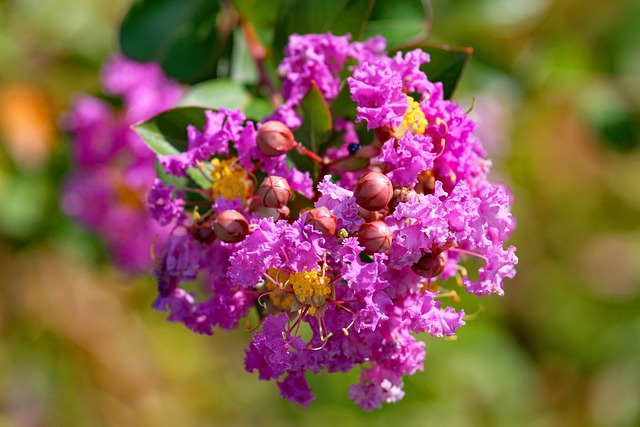
Discovering Lagerstroemia Indica: The Charming Crape Myrtle
When it comes to adding a splash of color to gardens and landscapes, few plants can compete with Lagerstroemia indica, commonly known as the crape myrtle. This stunning flowering shrub or small tree has captured the hearts of many gardening enthusiasts, especially in the warmer regions of the United States. 🌸
A Little Background
Originating from China, the crape myrtle has made its way into the hearts and gardens of many across the globe. It’s not just a pretty face; this plant is known for its resilience and adaptability, thriving in USDA Zones 6 to 10. Its ability to flourish in hot, humid climates makes it particularly popular in the American South, where it has become a symbol of the region's lush landscapes.
Why Choose Crape Myrtle?
There are several reasons why crape myrtles are a favorite among gardeners:
- Stunning Blooms: Crape myrtles are famous for their vibrant flowers, which can range from white to pink, red, and purple. These blooms typically appear in the summer, creating a beautiful display that can last for several months.
- Low Maintenance: One of the best aspects of crape myrtles is their low maintenance needs. They are relatively drought-tolerant once established and require minimal pruning.
- Versatile Size: Depending on the variety, crape myrtles can grow anywhere from a few feet tall to over 30 feet, making them suitable for various garden spaces.
- Year-Round Interest: Beyond their summer flowers, crape myrtles offer attractive bark and fall foliage, ensuring they remain a focal point in the garden throughout the year.
Planting and Care Tips
If you're considering adding a crape myrtle to your garden, here are some helpful tips:
- Location: Choose a spot that receives full sun for at least six hours a day. Crape myrtles thrive in sunny locations, which enhances their blooming potential.
- Soil: They prefer well-draining soil. While they can tolerate a range of soil types, good drainage is essential to prevent root rot.
- Watering: Water young plants regularly until they are established. Once they’re settled, crape myrtles are quite drought-tolerant.
- Pruning: Light pruning can help shape the plant and promote better airflow. However, avoid heavy pruning, which can lead to unsightly growth.
Common Varieties
There are numerous varieties of crape myrtle, each with its unique charm. Some popular ones include:
- ‘Natchez’: Known for its white flowers and stunning bark.
- ‘Muskogee’: Features lavender blooms and is a great choice for larger spaces.
- ‘Catawba’: Offers vibrant purple flowers and a compact growth habit.
Final Thoughts
Incorporating Lagerstroemia indica into your garden can bring a delightful burst of color and charm. With their stunning flowers, low maintenance requirements, and versatility, crape myrtles are truly a gardener's dream. So why not consider adding one to your landscape? Your garden will thank you! 🌿

















 Discovering Devotion by Dolce & Gabbana
Discovering Devotion by Dolce & Gabbana 
 Health
Health  Fitness
Fitness  Lifestyle
Lifestyle  Tech
Tech  Travel
Travel  Food
Food  Education
Education  Parenting
Parenting  Career & Work
Career & Work  Hobbies
Hobbies  Wellness
Wellness  Beauty
Beauty  Cars
Cars  Art
Art  Science
Science  Culture
Culture  Books
Books  Music
Music  Movies
Movies  Gaming
Gaming  Sports
Sports  Nature
Nature  Home & Garden
Home & Garden  Business & Finance
Business & Finance  Relationships
Relationships  Pets
Pets  Shopping
Shopping  Mindset & Inspiration
Mindset & Inspiration  Environment
Environment  Gadgets
Gadgets  Politics
Politics 